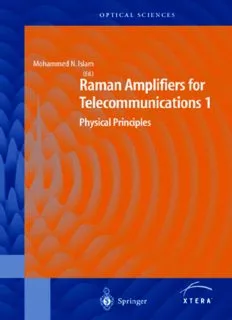
Raman Amplifiers for Telecommunications PDF
Preview Raman Amplifiers for Telecommunications
SpringerSeriesin optical sciences 90/1 FoundedbyH.K.V.Lotsch Editor-in-Chief: W.T.Rhodes,Atlanta EditorialBoard: T.Asakura,Sapporo K.-H.Brenner,Mannheim T.W.Hänsch,Garching T.Kamiya,Tokyo F.Krausz,ViennaandGarching B.Monemar,Linköping H.Venghaus,Berlin H.Weber,Berlin H.Weinfurter,Munich Springer NewYork Berlin Heidelberg HongKong London Milan Paris Tokyo SpringerSeriesin optical sciences The Springer Series in Optical Sciences, under the leadership of Editor-in-Chief William T. Rhodes, GeorgiaInstituteofTechnology,USA,andGeorgiaTechLorraine,France,providesanexpandingselec- tionofresearchmonographsinallmajorareasofoptics:lasersandquantumoptics,ultrafastphenomena, opticalspectroscopytechniques,optoelectronics,quantuminformation,informationoptics,appliedlaser technology,industrialapplications,andothertopicsofcontemporaryinterest. Withthisbroadcoverageoftopics,theseriesisofusetoallresearchscientistsandengineerswhoneed up-to-datereferencebooks. Theeditorsencourageprospectiveauthorstocorrespondwiththeminadvanceofsubmittingamanu- script.SubmissionofmanuscriptsshouldbemadetotheEditor-in-ChieforoneoftheEditors.Seealso http://www.springer.de/phys/books/optical_science/ Editor-in-Chief WilliamT.Rhodes FerencKrausz GeorgiaInstituteofTechnology ViennaUniversityofTechnology SchoolofElectricalandComputerEngineering PhotonicsInstitute Atlanta,GA30332-0250,USA Gusshausstrasse27/387 E-mail:[email protected] 1040Wien,Austria E-mail:[email protected] and Max-Planck-InstitutfürQuantenoptik Hans-Kopfermann-Strasse1 EditorialBoard 85748Garching,Germany ToshimitsuAsakura Hokkai-GakuenUniversity BoMonemar FacultyofEngineering DepartmentofPhysics 1-1,Minami-26,Nishi11,Chuo-ku andMeasurementTechnology Sapporo,Hokkaido064-0926,Japan MaterialsScienceDivision E-mail:[email protected] LinköpingUniversity 58183Linköping,Sweden E-mail:[email protected] Karl-HeinzBrenner ChairofOptoelectronics HerbertVenghaus UniversityofMannheim InstituteofComputerEngineering Heinrich-Hertz-Institut B6,26 fürNachrichtentechnikBerlinGmbH 68131Mannheim,Germany Einsteinufer37 E-mail:[email protected] 10587Berlin,Germany E-mail:[email protected] TheodorW.Hänsch HorstWeber Max-Planck-InstitutfürQuantenoptik TechnischeUniversitätBerlin Hans-Kopfermann-Strasse1 OptischesInstitut 85748Garching,Germany Strassedes17.Juni135 E-mail:[email protected] 10623Berlin,Germany E-mail:[email protected] TakeshiKamiya MinistryofEducation,Culture,Sports HaraldWeinfurter ScienceandTechnology Ludwig-Maximilians-UniversitätMünchen NationalInstitutionforAcademicDegrees SektionPhysik 3-29-1Otsuka,Bunkyo-ku Schellingstrasse4/III Tokyo112-0012,Japan 80799München,Germany E-mail:[email protected] E-mail:[email protected] Mohammed N. Islam (Ed.) Raman Amplifiers for Telecommunications 1 Physical Principles Foreword by Robert W. Lucky With222Figures MohammedN.Islam DepartmentofElectricalEngineeringandComputerScience UniversityofMichiganatAnnArbor 1110EECSBuilding 1301BealAvenue AnnArbor,MI48109-2122 [email protected] and XteraCommunications,Inc. 500WestBethanyDrive,Suite100 Allen,TX75013 USA [email protected] LibraryofCongressCataloging-in-PublicationData Ramanamplifiersfortelecommunications1:physicalprinciples/editor,MohammedN.Islam. p.cm.–(Springerseriesinopticalsciences;v.90/1) Includesbibliographicalreferencesandindex. ISBN0-387-00751-2(hc.:alk.paper) 1.Fiberoptics. 2.Opticalcommunications. 3.Ramaneffect. 4.Opticalamplifiers. I.Islam,MohammedN. II.Series. TL5103.592.F52R352003 (cid:1) 621.38275–dc21 2003044945 ISBN0-387-00751-2 ISSN0342-4111 Printedonacid-freepaper. ©2004Springer-VerlagNewYork,Inc. Allrightsreserved.Thisworkmaynotbetranslatedorcopiedinwholeorinpartwithoutthewritten permissionofthepublisher(Springer-VerlagNewYork,Inc.,175FifthAvenue,NewYork,NY10010, USA),exceptforbriefexcerptsinconnectionwithreviewsorscholarlyanalysis.Useinconnectionwith anyformofinformationstorageandretrieval,electronicadaptation,computersoftware,orbysimilaror dissimilarmethodologynowknownorhereafterdevelopedisforbidden. Theuseinthispublicationoftradenames,trademarks,servicemarks,andsimilarterms,eveniftheyare notidentifiedassuch,isnottobetakenasanexpressionofopinionastowhetherornottheyaresubject toproprietaryrights. PrintedintheUnitedStatesofAmerica. 9 8 7 6 5 4 3 2 1 SPIN1091952190/1 www.springer-ny.com Springer-Verlag NewYork Berlin Heidelberg AmemberofBertelsmannSpringerScience+BusinessMediaGmbH To my loving wife, Nasreen This page intentionally left blank Foreword IremembervividlythefirsttimethatIheardaboutthefiberamplifier.Atthattime, of course, it was the erbium-doped fiber amplifier, the predecessor of the Raman amplifierthatisthesubjectofthisbook. ItwasanearlymorninginaforgottenyearinMurrayHill,NewJerseyatoneof ourBellLabsmonthlyresearchstaffmeetings.Abouttwentydirectorsandexecutive directors of research organizations clustered around a long table in the imposing executiveconferenceroom.ArnoPenzias,thevicepresidentofresearch,presidedat thefootofthetable. Everyonewhoparticipatedinthoseresearchstaffmeetingswilllongremember theircultureandatmosphere.Arnowouldpickanarbitrarystartingpointsomewhere aroundthetable,andthedesignatedpersonwouldheadtothefrontofthetabletogive ashorttalkon“somethingnew”inhisorherresearcharea.Thisfirstspeakerwould invariablyfiddlehelplesslywiththecontrolsembeddedinthepodiumthatcontrolled the viewgraph projector, but eventually we would hear machinery grinding in the back room as a large hidden mirror moved into place. We would all wait quietly, arranging and choosing our own viewgraphs from the piles that lay on the table in frontofeveryparticipant. Therulesforthestaffmeetingwerethateachspeakerwasallowedsevenminutes andthreeviewgraphs.However,inspiteofArno’sbesteffortstoenforcethisregimen, everyonetooktoolongandusedtoomanyviewgraphs.Variousattemptsatusingloud timersandotherincentivesallfailed.Noonecouldgivearespectabletalkonaresearch topicforwhichtheyhadpassionatefeelingsinsevenminutes. Another rule was that anyone could forfeit his talk by simply saying, “I pass.” This forfeiture was always accepted without comment, but new directors always asked their friends about whether this would constitute a black mark against their performance.Nooneknewforsure,butrumorhaditthatitwasunwisetopassunless youweretrulydestituteofmaterial.Afterall,theimplicationwouldbethattherewas nothingnewinyourresearchorganizationforthelastmonth—notagoodindication ofyourmanagementskills. Withnoonepassing,andeveryonespeakingtoolong,thesestaffmeetingssome- timesseemedendless.Computerscientistswouldtalkaboutnewconstructsinsoft- viii Foreword ware,systemspeoplewouldtalkaboutnewtechniquesforspeechrecognition,physi- cistswouldtalkaboutsomenewlaser,chemistswouldshowdiagramsofneworganic materials,andsoforth.Itdidn’ttakelongforeachtalktoexceedtheunderstanding ofmostlistenersofwhateverspecialtywasbeingdiscussed.Ialwaysleftwithapro- foundsenseofthelimitationsofmyownknowledge,butwithanexhilaratinginkling intotheunfoldingofscience.Itwas,perhaps,thebestoftheoldresearchmodelin BellLabs,andinretrospectIcansaythatinthisnewcompetitiveworldImissthose oldscientific-stylemanagementmeetings. ItwasinsuchameetingthatIfirstheardaboutthefiberamplifier.Idon’tknow whetherIhadbeenpayingattention,butIwasimmediatelygalvanizedbytheimpli- cationsofthisnewdiscovery.Onewordcametomeandblazedacrossmymind:that wordwas“transparency.” Surprisingly, in my experience I am not always immediately enthusiastic about anewtechnologyuponinitialexposure.Onemightthinkthatthepotentialsofgreat breakthroughs are self-evident, but that does not seem to be the case. When I first heardabouttheinventionofthelaser,Ihadnopremonitionthatlaserswouldbecome the primary instrument of the world’s telecommunications traffic.When one of the inventorsofpublickeycryptographytoldmehisideaforhavingtwokeys,Iscoffed atthenaivetéofhisconcept.Irememberthinkingonfirsthearingaboutwhatisnow theprincipalalgorithmfordatacompressionthatIthoughtitwasonlyatheoretical exercise.Somytrackrecordforsuchinsightsisnotaltogethergood. However,withthefiberamplifierIwenttotheotherextreme.Iforesawadramatic revolution in communications. I spoke up at the staff meeting that morning to say that this invention would transform the architecture of communications networks. Thiswouldleadtotransparentnetworks,Isaid,andthatthiswouldnotnecessarily begoodforAT&T.Igotcarriedawaywiththisvision,andwentontosaythatpri- vatenetworkscouldhavetheirownwavelengthstravelingtransparentlythroughthe network,untouchedbythecommoncarrierinthemiddle.Oneprivatenetworkmight have“blue”light(figurativelyspeaking,ofcourse,becausewe’renottalkingabout visible wavelengths) whereas another would have “green.” I foresaw a plug on the wallthatpassedonlythechosenwavelength,whichwouldbeownedexclusivelyby thatparticularcustomer’snetwork.AT&Twouldthusbedeprivedoftheopportunity to process signals for value-added services.AT&T, in fact, wouldn’t have any idea whatwaspackedintothosewavelengths. Well,thathasn’texactlyhappened,buttoday’sopticalnetworksaremovingto- wards increased transparency, and Raman amplifiers will accelerate this trend.The advantagesoftransparencyarecompelling.Agreatmanyconstituentsignalscanbe amplifiedcheaplyinonefellswoop.Moreimportantly,thisamplificationisindepen- dentofthebitrates,protocols,waveforms,multiplexing,oranyotherparticularsof thetransmissionformat.Thedesignisn’t“lockedin”toanyspecificformat,andas thesedetailschange,theamplificationremainsaseffectiveasever.Inthecaseofthe Raman amplifier, the bandwidth is so enormous that adjectives seem inadequate to describeitspotentialforbulkamplification. Transparencyinthenetworkissoattractivethatprobablytheonlyreasonitisn’t done is that it is so difficult to achieve. One reason is, of course, the necessity for periodicallyunbundlingthesignaltoaddordropsubcomponents.Inthedigitalworld Foreword ix thishasusuallymeantacompletedemultiplexingandremultiplexingoftheoverall signal,anexpensiveoperation.Theopticalworldopensupthepossibilityofselective transparency for certain wavelengths whereas others are unpacked to do add-drop multiplexing. Sonetworktopologysetslimitsontransparency.Buttheotherreasontransparency ishardtoachieveistheimplicitaccumulationofimpairmentsasasignalincurssucces- siveamplifications.Itisironicthatthetelephonenetworkwasessentiallytransparent forthefirsthalf-centuryofitsexistence.Until1960thelong-haultransmissionsys- tems used analogue amplification to boost levels as the signal traversed the nation. Theinventionofthetriodevacuumtubeenabledthefirsttranscontinentaltransmis- sionsystemtobedeployedinthe1920s.Itwasamarvelousfeattobeabletosenda bandofsignals3000milesacrossthecountry,passingthroughmanyamplifiers,ac- cumulatingnoiseanddistortionalongtheway,butstillprovidingintelligiblespeech attheotherend.Someolderreaderswillrememberwhenlongdistancephonecalls soundedcracklyand“distant.”Now,ofcourse,itisimpossibletotellhowfaraway aconnectionis.Theyallsoundlocal,becauseofdigitaltransmission. Digitaltransmissionwasthetriumphofthe1960s.Thoughnowitseemsobvious, engineersfoundthephilosophyofdigitizationhardtograspforseveraldecadesafter theinventionofpulsecodemodulationbyReevesin1939.Thereisatrade-offhere: bandwidthagainstperfectibility.A3kHzvoicesignal,forexample,istransformedby ananalogue-to-digitalconverterintoa64,000kbpsstreamofbits,greatlyexpanding the necessary transmission bandwidth. However, this digital signal can be regener- atedperfectly,removingnoiseanddistortionperiodicallyasnecessary.Amiracleis achievedasthebitsarriveacrossthecountryinthesamepristineformaswhenthey left. So it was that all long distance transmission was converted to digital format. The introduction of the first lightwave transmission systems hurried this change, inasmuchaslightwavesystemsweredeemedtobe“intrinsicallydigital”becauseof theirnonlinearitiesandthelackofamplifiers.Noonecaredmuchatthetime—the early1980s—buttheentiredesignofthenetworkwaspredicatedonthetransmission of64kbpsvoicechannels.Themultiplexinghierarchy,theelectronicswitching,the synchronizationandtiming,andthetransmissionformatassumedthateverythingwas packaged into neat little voice channels.That, of course, was before the rise of the Internet. Nowopticalamplificationhasreversedthistrendofthelasthalf-centurytowards digitizationbaseduponahierarchyofvoicesignals.Itisn’tjustthatopticalamplifiers haveanenormousbandwidth.Theydosomethingthoseoldtriodevacuumtubescould neverdo:theyamplifywithoutsubstantiallyincreasingthenoiseanddistortionofthe signal.Ramanamplifiersareparticularlygoodinthisway.Moreover,becauseRaman amplificationisdistributedacrossthewholespanofthefiber,thesignallevelnever drops as low as it does when discrete amplifiers are employed. In a system using discrete amplifiers the signal level is at its lowest and most vulnerable right before thepointofamplification. Back at that research staff meeting I was concerned about the implications of transparencytothearchitectureofthenetwork.Atransparentnetworkis,bydefinition, a “dumb” network. It doesn’t do anything to the signal; it can’t, because it doesn’t
Description: